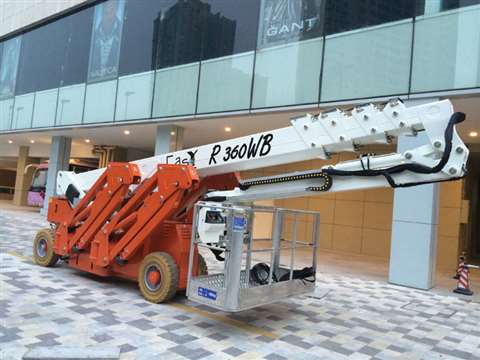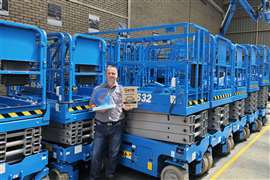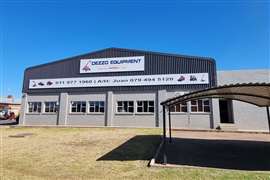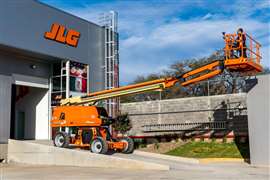Hybrid focus
25 August 2015

The hybrid AWP is increasingly spoken about as a cost-effective and environmentally-friendly choice. Euan Youdale explores how far the sector has come and where it is heading over the next few years.
The hybrid aerial platform is still a niche product and it is unlikely to be dominant in rental fleets over traditionally combustion engine powered products, certainly in the immediate future. It could even be that the lithium-ion battery has a brighter future when used as a single power source.
Nevertheless, hybrids are becoming increasingly common, particularly in established markets like Europe and North America for inside construction applications and industrial applications. This may lead to greater use on outside construction sites as the technology develops. The benefits being cost efficiency, noise reduction, lower pollution and the fact they can be used across a range of applications inside and out.
At this point it is worth differentiating hybrid and bi-energy tracked platforms from booms and scissors, particularly in the rental sector where they are a niche product. A relatively high proportion of tracked platforms already use this technology compared to scissors and booms as it is often complementary to their core use. And while rental companies commonly have a handful of tracked platforms in their fleets it is few compared to the conventionally-powered scissors and booms.
Chris Banks, technical director at UK-based distribution specialist Access Platform Sales, part of the IAPS Group, provides his view of the hybrid sector. “The advantage of the hybrid is it can be used in a multitude of places because you can use it on battery or mains internally, yet if you have an external use you can still power it with the battery, but if that starts to get low you can use it with the engine or just the engine.”
Despite this, hybrid has its limitations. “A rental company would probably use a hybrid machine internally or around a factory-type environment – more industrial applications rather than construction applications. On a construction site it would probably use a fully diesel machine, however it’s not to say some hybrids couldn’t work on that site, particularly where they are purely being used inside.”
Partly it’s a question of technology and the ability of hybrids to match their combustion engine counterparts. “The drive system in new hybrids now is getting so good. Before, an electric machine had very poor gradeability, now the gradeability is getting better so it is possible that we may see some of these big diesel-only four wheel drives disappear.”
In competition
As Corey Raymo, global category director, boom lifts, at JLG, explains, there are two types: Series hybrid and parallel hybrid. JLG’s products are considered as series hybrids. “In series hybrid technology, the engine and electric motor or generator are independent and the electric drive or traction motors can be powered by the batteries alone, which are assisted by the combustion engine.” In the parallel system both motors contribute to the propulsion, possibly at the same time.
Hybrids have some competition, with a serious contender being lithium-ion battery technology used on its own without any other power source as a back-up. The light weight of the battery pack, its longevity, short charging times and greater usage periods are all advantages, says Mr Banks.
“You can get one day’s use out of a lithium machine at the moment and depending on the network you can charge the pack to around 80% in around two hours and after about 8000 working hours the pack will still be about 80% of what they were originally. “You would know no difference in performance with the lithium machines that are on the market compared to a diesel engine, accept there is no noise.”
Mr Banks believes the lithium will generally remain as an independent power source, although it is quite possible we will see a lithium hybrid with a diesel/petrol engine that charges the lithium pack. The only disadvantage is the relatively high cost compared to other types of batteries or indeed combustion engines. “In certain applications the lithium outweighs the other machines so much the customer is prepared to pay a premium. As more and more manufactures use lithium the technology and the price will come down. I guess we could be talking five or 10 years down the line.”
Despite these considerations, Mr Banks is of the view there will always be a place for hybrids. “With any battery-powered machine there is always the limitation that at some point you will run out of battery power. If you have the ability to recharge that battery pack via a diesel or petrol engine, you broaden the use of the machine, meaning it is not just for one customer and can be used for many different types of applications.
He says, “I see existing electrics decreasing as hybrids take slightly more percentage, however I think there will always be a market for electric machines,” adding, “I think Europe and the USA will increase their percentage of hybrid and lithium machines.”
Rental perspective
Many rental companies are still cautious about the adoption of hybrid machines, particularly outside of the USA and Europe where their benefits are not yet required. However, even in those mature markets, rental companies would pause for breath before suggesting they will ever take over from mainstream scissors and booms in the construction sector.
For example, in the USA, rental giant NES Rentals has few hybrids in its fleet. “We don’t have many hybrids and don’t have any specific plans to add more. We will buy hybrids as necessary and as customer demand dictates,” says a company spokesman. As far as tracked platforms are concerned, it has around 20 units.
European major Riwal has invested in a number of hybrids, including Holland Lift’s HL275 H25 and JLG’s M3369LE and M4069LE scissors and JLG H340 AJ, M450 and M600 booms. “We will continue to invest in hybrid scissor and boom lifts as these machines will enable our customers to work for a longer period on a jobsite - outside on rough terrain as well as inside. This will save our customers time to off-rent and on-rent machines as well as bring savings in transport costs,” explains Søren Rosenkrands, Riwal’s COO.
The company’s technical manager Nico den Ouden, adds that for working heights where no environmentally friendly boom lifts are available on the market, Riwal has converted diesel machines to electric, including the JLG 800AJ and JLG 860SJ. “We will be looking at converting machines of even higher working heights, depending on the customers’ request.”
However, Mr Rosenkrands is assured hybrid machines will be of increasing importance to Riwal’s fleet, “They respond to a market need for more versatile and environmentally-friendly machines with reduced emissions, lower noise levels as well as fuel savings.”
Higher investment
These machines are being used in construction and maintenance where lower noise levels or lower pollution is required such as city centres, offices, close to hospitals, in tunnels and indoor maintenance. Also multi-storey buildings where interior works are required. “For us the investment in a hybrid machine is higher compared to conventional access equipment and the maintenance costs are higher, “explains Mr Rosenkrands, “The challenge is to explain the added value of a hybrid machine to the customer and charge the appropriate rental rate. The customer will pay for it when there is a specific application for the hybrid use. We expect it will remain a niche product for quite some time.”
To ease these challenges, Riwal hopes manufacturers create ‘smarter batteries’ with stronger output, as well as, ‘smarter electric motors’ that are maintenance-free. “We believe that one of the key drivers is that larger construction companies increasingly incorporate sustainability in their strategy and set environmental objectives to reduce their footprint. This includes more sustainable construction projects using more environmentally-friendly equipment,” adds Mr Rosenkrands.
Europe and the USA are likely to adopt these changes more quickly than other markets, “Companies there are more environmentally-conscious and also governments have a higher focus on reduced emission and noise levels.”
Trends in Japan
Nikken Corporation, based in Japan, has a few Z-Boom Genie hybrids in its fleet. Hiroshi Horinouchi, executive officer and general manager, corporate planning office, Nikken Corp, says, “We don’t have any plans to increase our volume of hybrid scissors and boom fleets. There is limited demand for such hybrid equipment from our customers in Japan.”
Mr Horinouchi does not see any major changes to the current situation in the short term. “It may change to some extent in the long run, like more than 10 years, but we can’t tell for the moment.”
It is simple, says Mr Horinouchi, the customer must see a benefit in the use of such equipment before investing in it. “Customers need to see a reduction in their operating costs by using hybrid equipment.” Ultimately, that means, “Low cost production to persuade rental customers to accept hybrid equipment.”
At the moment in Japan, “Users are satisfied with the efficiency of machines available today and there is no reason to purchase high-cost equipment for the time being.”
Future interest
TVH Equipment NV in Belgium, doesn’t have any hybrid aerial work platforms in its fleet at the moment, apart from its Teupen tracked units, which it considers to be bi-energy, meaning most of them are equipped with a diesel engine as main power source, but can also work on 230V main power supply, although not batteries.
Jean-Pierre De Nil, director access equipment, believes that situation may change in the near future, “We are actually considering investing in some specific units in this segment although the demand for this product is not yet really present in our market.”
These investments will likely include hybrid diesel scissor lifts, specifically for high-bay racking systems - not only to construct the rack but the sprinklers and other associated installations too. Looking to the future five, 10 and 15 years, Mr De Nil, believes the proportion of hybrids in the fleet will rise to 1%, 5%, 10%, respectively.
“I think that the lifecycle of the batteries and also the cost are the topics that create a lot of doubt about these machines. Lithium might be a technology that tackles this, although it is still very expensive,” adds Mr De Nil.
The industry may be forced to make these technological leaps as emission regulations, particularly in mature markets like Europe and North America become ever more stringent. “When they start to apply to the smaller sized engines, this will push rental companies strongly towards more electric powered machines - I doubt if it will push towards hybrids given the much higher cost of a hybrid machine at this moment.”
Manufacturers
JLG
Hybrids in the JLG camp are the 10.29 m platform height H340AJ, 18.39 m platform height M600JP and the 13.72 m platform height M450AJ booms. All JLG hybrids are series hybrid rather than parallel hybrid. For example, the H340AJ combines diesel fuel and an electric power system, providing the power and durability of a diesel-powered machine while saving operational costs. It is quieter, less than 69 decibels, and produces fewer carbon emissions. It has four independent electric-drive motors that provide rough terrain performance with a Tier 4 diesel-powered generator for recharging. Electric power is stored in eight 6V batteries, each requiring less recharging time than lead acid batteries.
According to the manufacturer, “Many of the technologies present in AWPs today were pioneered in automotive years ago. Examples include GPS, telematics, system sensors, control systems, etc. Hybrid systems and technology could likely follow a similar path. When adoption of a new technology, like hybrid technology, is low and the concept is new, OEMs may be limited in the types of hybrid technologies they can offer. “Fleet owners and end-users are becoming more and more cost-conscious, and fuel and maintenance costs are one of those factors that could sway a fleet owner to a hybrid.”
Genie
Genie has three hybrid booms, the Z-34BE, Z-45BE, TZ-50BE and three scissors, the GS-2669BE, GS-3369BE, and GS-4069BE. The Genie bi-energy system currently used on the Z34 and Z45 boom lifts, for example, consists of eight six volt batteries and a T4F 13hp diesel driven alternator. Running the engine provides nearly 100 amps of power sufficient for machine functions and charging the batteries. The machine can also be operated strictly from battery power in areas that require low noise or no emissions.
The GS-69BE rough terrain scissor lift bi-energy system consists of eight six volt batteries incorporating an integrated, onboard TF4 6.7hp diesel engine direct driving a 2.4 kW generator. The system is capable of simultaneously and automatically self-charging the batteries and powering AC power hand tools at the platform or on the ground. When in Hybrid mode, the power management system automatically monitors the state of the batteries and controls the operation of the onboard generator.
Genie says, “Hybrid systems are quickly finding their place in the aerial market. Fleet owners are able to leverage the flexibility of indoor/outdoor performance for longer term rentals and higher utilisation. The industry continues to focus on productivity and ROIC and hybrid systems will support this focus. “As emissions standards continue to increase the complexity of the diesel engine systems, hybrid and electric systems will provide alternatives that become comparatively more cost effective.”
Manitou
Manitou’s AWP range offers the 150AETJ Bi-Energy and 170 AETJ Bi-Energy. These two models have a 15 m and 17 m working height, respectively. The main power source of the machine is electric, batteries, which run an electric pump and engine wheel motors. A small 9KW Lombardini engine is fitted and charges the batteries when needed. The machine can then be used inside using batteries and outside, the engine is used to charge the batteries and a provide power to wheel motors. “Hybrids still represent a bigger investment in the future than traditional technologies, that’s why these products will progress slowly in the rental fleets. Mentalities are changing and people are more and more aware of environmental issues. If regulations become stricter then behaviours could change quickly.”
Skyjack
Skyjack offers the SJ6832 RTE. It marries the benefits of its diesel-powered counterpart with an electric engine. The electrically-powered rough terrain scissor can still elevate 454 kg to 9.8 m but the package is narrower and lighter. Built on the same chassis as the existing diesel and dual fuel 68RT units, it features a 16 hp AC electric motor as standard, Skyjack also offers a hybrid powerpack variant featuring a 2.2 kW genset, which provides on-board power to recharge the 48V 250Ah battery pack, while the machine is working. The operator can set the system to automatic mode, whereby the generator will start and provide battery charging when the operating charge reaches 50%.
Haulotte
Haulotte offers two self propelled boom lifts that come standard with hybrid power. The 45 XA and 55 XA use a system that combines a petrol or diesel engine with batteries. The IC engine and batteries work together to power the travel function, and the batteries power the boom functions, with recharging provided by a generator that’s driven by the engine. The 45 XA has a maximum working height of 15.5 m and the 55 XA has a working height of 18.7 m. Both have a maximum platform capacity of 227 kg.
Omme Lift
Omme Lift prides itself in its ‘true hybrid’ offering and provides a range of hybrid trailer and crawler mounted models, including the 16.6 m 1650 EBD - 29 m 2900 EBD trailers and 17.2 m 1750 - 42 m 4200 RBDJ crawler mounts. The Omme system has a diesel/battery and petrol/battery drive train.
The lifts offer an on-board charger during lift operation without interruption. The batteries are automatically re-charged by a generator when the engine is running. When the engine is started up, there is an automatic transfer from battery to engine power and vice versa. The engine can be used where heavy, constant performance is required and full battery for operation in areas where air or noise pollution is regulated. “We believe that hybrids are very important to rental fleets. Lifts that are only used indoors can rely on just battery power. However, the rental fleet needs lifts that are flexible so they have the capacity for indoor and outdoor use. You can always improve and modify the technique, for example by, using lithium batteries.”
Holland Lift
Holland Lift’s 27.5 m working height HL-275 H25 scissor has a 1000 kg basket load. By using parallel technology, the batteries are not used unnecessarily, thus making its lifespan longer and the machine more reliable. The scissor lift can be used without being dependant on a charging point. At the same time it can be used both inside and out. The battery capacity is sufficient for one to two full working days. If it should come to a stage the battery is empty, the machine can be run on generator mode. The diesel engine, electric motor and hydraulic pump are connected through one shaft and using a clutch the engine can be disengaged from the drivetrain.
Niftylift
The manufacturer has a complete hybrid range. For example, the HR28 Hybrid can lift three people and tools to a working height of 28 m or an unrestricted outreach of 19 m. Its system utilises power-optimised diesel supported by the machine’s batteries when extra power is needed. A Diesel Re-Gen feature recharges the batteries without a mains power source and the electric-only mode allows zero-emissions. The Advanced Exhaust Purification system, including catalytic converter, reduces emissions: particulates by 30%, hydrocarbons by 80% and carbon monoxide by 90%.
Bluelift
Blue lift offers all its line of tracked platforms up to 22 m working height as a hybrid option, except for the smallest 12 m working height C12 which is available only lithium. They can also be offered with hybrid option: lithium battery + combustion engine. The company says, “We started with the hybrid option in 2013, focusing especially on the USA.” This is because, “The 110 v in the USA is not enough for a good performance with a standard electric pump, so the hybrid option is the solution to this problem.”
MEC
MEC has the 4069ERT scissor lift, which combines battery power with a recharging genset. It has 40 foot maximum platform height and 800 pound lifting capacity.
Easy Lift
The manufacturer supplies all its tracked platforms as a hybrid version. The manufacturer has a small, medium and large range from the R130 with a 12 m working height to the R410 with a 41 m working height. The big machines can be supplied with tracks or wheels. The different hybrid systems on offer are: lithium battery + electric motor; traction battery + electric motor; lithium battery + electric motor + combustion engine, traction battery + electric motor + combustion engine. “The hybrids versions are in continuous development through new technologies from lithium battery as it more compact and quick to recharge. The main problems of hybrid tracked platforms are the small spaces they have to get into and the power consumption, we think that in the coming years the battery version will have smaller dimensions and consumption will be lower,” says Easy Lift.
France Elevateur
France Elevateur says all its range can be fitted with hybrid technology. It also fits electric-powered platforms on standard vans and trucks and offers a 100% electric platform and carrier. “We have been making machines with battery packs for more than 20 years for the national French electricity company ERDF, and have been following the evolution of this technology.”
For example, the 11 m Topy 11 to the 28 m 248 TBE has a hydraulic system with batteries which can supply enough power to work for 15 full cycles, and can be fitted with solar panels to help charge the batteries faster.
Palazzani
Palazzani uses the parallel system in its Ragno models, which can be recharged direct from 220 V mains power source. This system provides a better performing battery, says the manufacturer, and it guarantees more autonomy in electrical mode. In the system, the diesel motor activates the generator that charges the battery. The generator is connected to the diesel motor with a belt that multiplies the number of revolutions. The DC to AC inverters control the motors that activates the pump.






